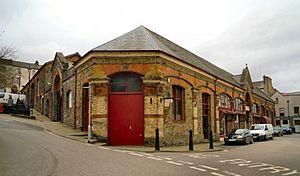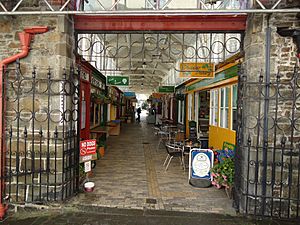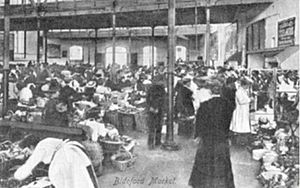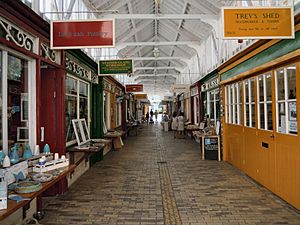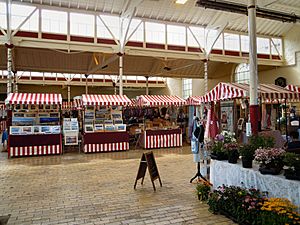Pannier Market, Bideford facts for kids
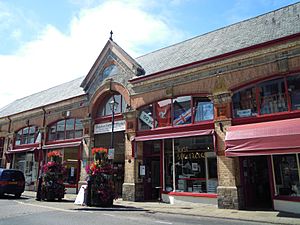
The Pannier Market in Bideford, North Devon, is a big, covered market built in the Victorian era. It also has a special area called Butcher's Row, which is full of small shops where artists and craftspeople work. There has been a market in this spot since 1675. Since 1989, it has been a Grade II listed building, meaning it's an important historical building.
Contents
The Market's Long Story
How It Started
Bideford's market started a very long time ago, in 1204. Sir Richard Grenville, who was the Lord of Bideford, wrote about the market in a special document called a Charter. This Charter explained the rights of local people. These rights were confirmed again in 1272 by King Henry III. Back then, the market was located near the river, at the bottom of what is now High Street. In 1573, Bideford got its own town council and a Mayor, and the market rights were renewed again.
A New Home and Improvements
In 1675, the town council decided to move the market from High Street to where it is today. At first, it was just a collection of stalls. There was also a "shambles," which was a special area for butchers.
By 1750, the Cleveland Family owned the market rights. A historian named John Watkins described the market as "very well supplied with all kinds of provisions." This means it had plenty of food and goods at good prices. As time went on, traders wanted better conditions. So, in 1825, a roof was added to the market for the first time. In 1861, a visitor said the market was "buzzing with a healthy, bustling good humoured crowd." People bought and sold horses and ponies outside, while sheep and other animals were kept in pens.
Building the Current Market
In 1881, Bideford Town Council bought the market rights from the Cleveland Family. The family didn't want to pay for more repairs. Between 1883 and 1884, the old market was taken down, and a new one was built. It was designed by an architect named J. Chudley and cost £4,200.
The new Pannier Market in Bideford opened on April 15, 1884. It was built with stone and red and cream bricks. The market was also used as a corn exchange, where farmers traded grain. Market days were Tuesdays and Saturdays, and people from nearby villages came to visit. Like the market in Barnstaple, this building has a roof made of glass and timber, supported by iron columns.
The opening of the market was a big celebration! The area was decorated with flowers, church bells rang, and there was a gun salute. The Mayor of Bideford led a procession. There was also a concert and a fancy dinner for 200 important local people. Later that week, a tea party was held for 2,000 local children!
Over the years, the Market Hall has been used for many things. In 1919, 900 soldiers who had just returned from war had a celebration dinner there. In 1929, a speech by David Lloyd George was played to 4,000 people in the hall. During tough times, a soup kitchen operated in the hall. In 1942, during World War II, a "British Restaurant" opened there, offering cheap meals to people working for the war effort.
In 1974, Torridge District Council took over the market. But in 1991, Bideford Town Council got control back. They completely updated the market, and this event is celebrated every December.
Butcher's Row
Butcher's Row is a covered area with 12 small shops. Today, these shops are home to talented artists and craftspeople. But long ago, they were used by butchers and fishmongers. You can still see some meat hooks in place!
In these shops, you can find amazing things like stained glass, handmade jewelry, and metal sculptures. You might even see wood sculptures carved by John Butler, who used to be an animator for the famous cartoon Roobarb and Custard. There are also special pottery jugs made by Harry Juniper. You can often watch the craftspeople as they create their beautiful items.
Butcher's Row is open from Monday to Saturday all year round.
Market Hall
The Market Hall is a huge covered space, about 1,000 square meters. You can get into it from Honestone Street or by walking up steps from Butcher's Row. The roof of the Market Hall is supported by strong iron columns. These columns even have the names of the companies that made them and the year 1883 carved into them! The floor is made of cream-colored bricks.
Inside the Market Hall, you'll find many different stalls. They sell fresh local food, handmade soft furnishings, toys, local greeting cards, and gifts. You can also find workshops for stained glass, hand-painted pictures, and second-hand books. There's even a café where you can grab some food and drinks.
The Market Hall is open from Tuesday to Saturday throughout the year.
Market Place
Market Place is a row of seven shops located at the entrance to the Market and Butcher's Row on Grenville Street. In the Victorian era, the fish market and corn exchange were at either end of this row. Today, these shops still have their original Victorian look with big windows. They sell all sorts of goods, from fishing gear to collectibles.
The local Council offers a free minibus service on Tuesdays and Saturdays. It runs every twenty minutes, from 10:00 am to 2:40 pm. The bus takes people to and from the Market from a spot on the Quay, near the Charles Kingsley statue at Victoria Park.


